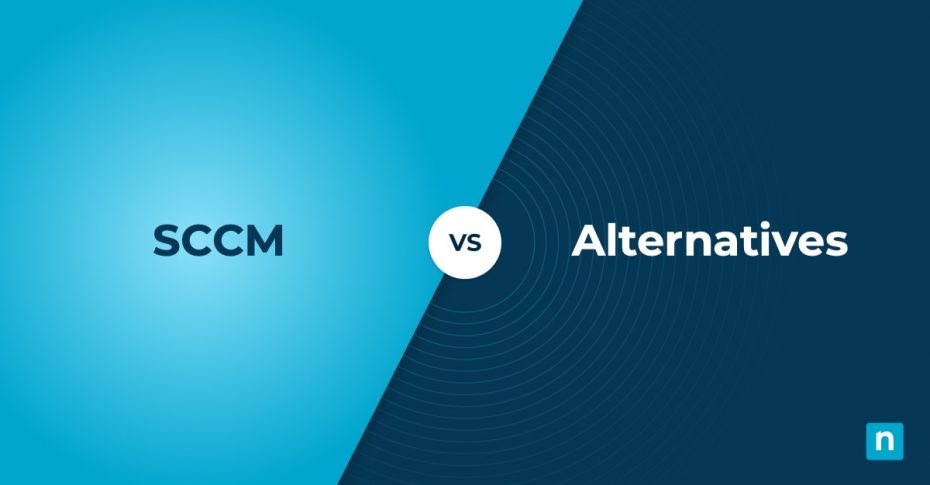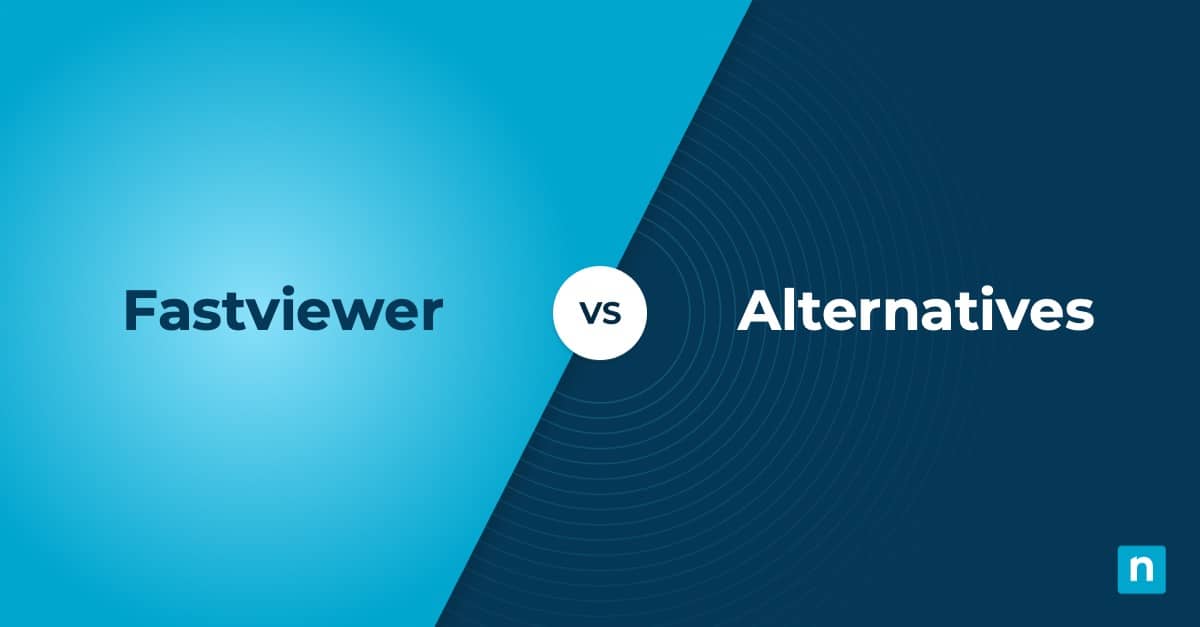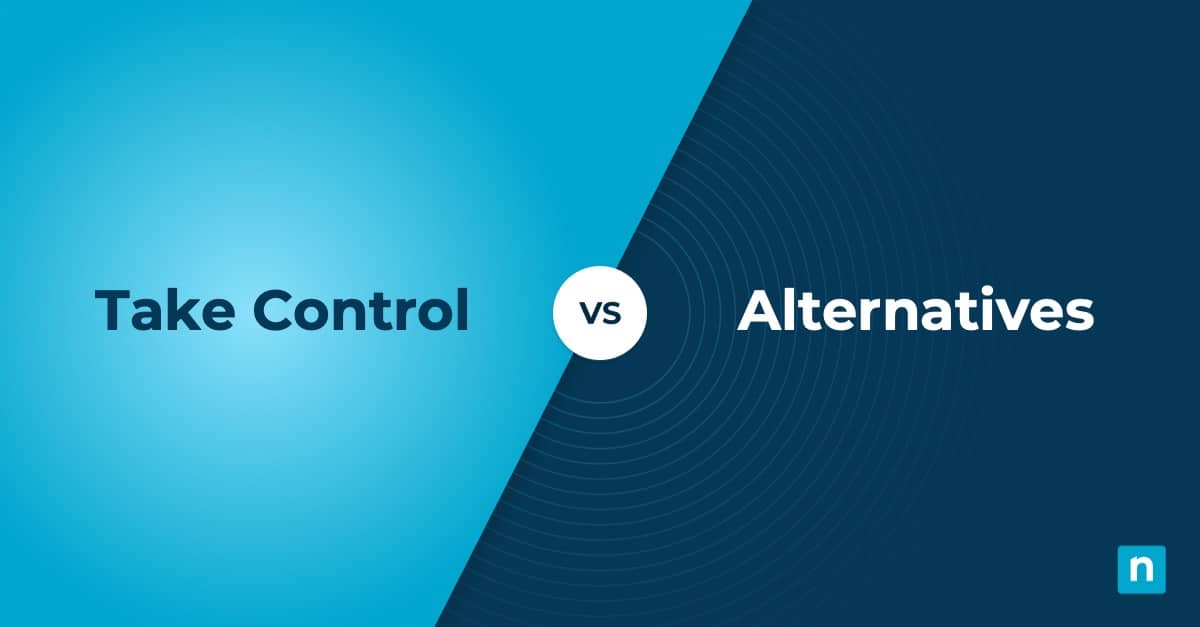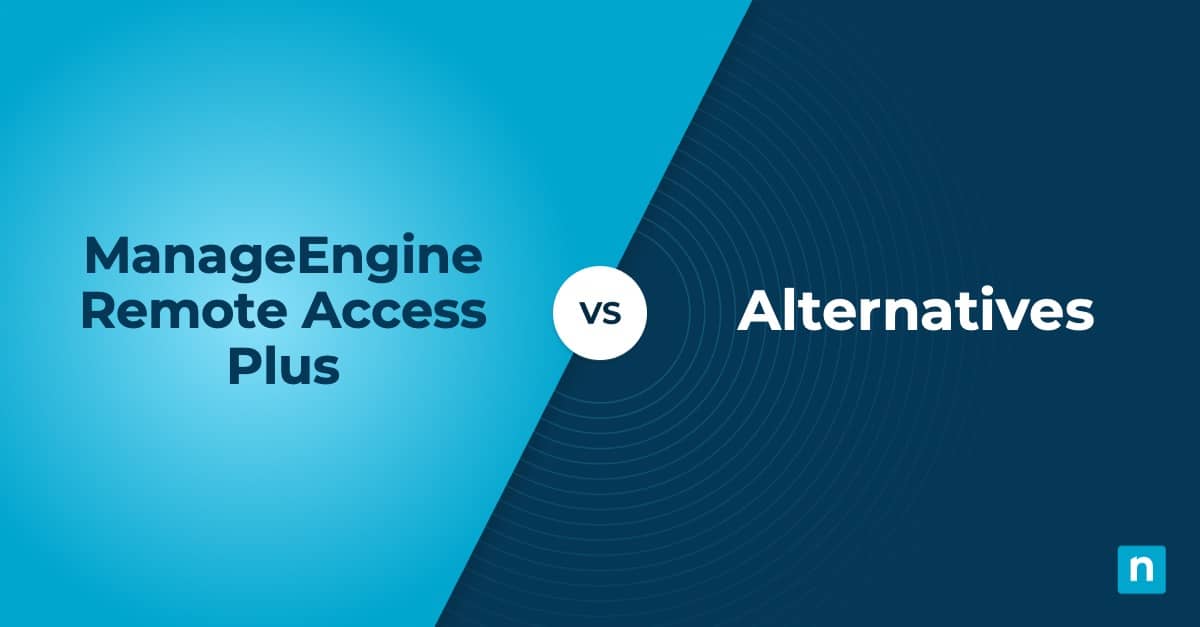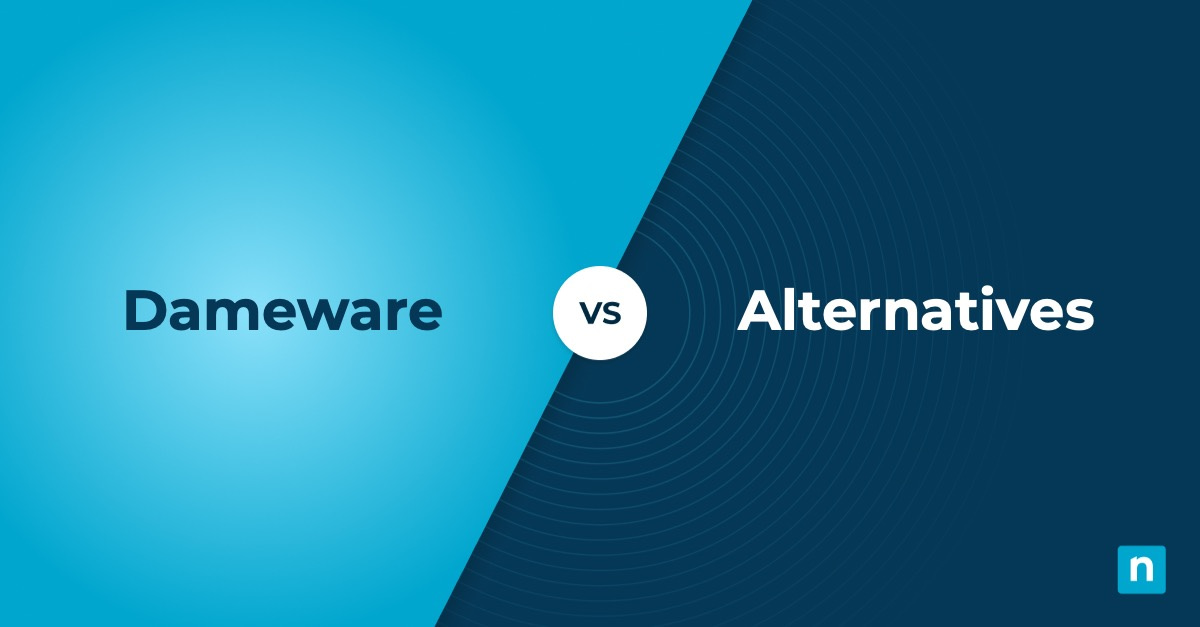Key Points
- SCCM is Microsoft’s on-prem solution for deploying, managing, and securing Windows devices and apps.
- Microsoft now promotes Intune for cloud-based endpoint management, though SCCM still exists.
- WSUS vs. SCCM
- WSUS: Basic Windows update distribution.
- SCCM: Builds on WSUS, adding central patch management, third-party updates, and deeper controls.
- 10 Alternatives to SCCM
-
- NinjaOne: Cloud-based, cross-platform, top-rated support.
- Automox: Broad OS coverage, powerful automation.
- Patch My PC: Extends SCCM/Intune with third-party app patching.
- Atera: Full IT management suite with automation.
- Action1: Cloud-native with real-time vulnerability scanning.
- SolarWinds Patch Manager: Enhances SCCM/WSUS for third-party patches.
- PDQ Deploy: Automates Windows app deployments.
- HCL BigFix: Enterprise-level, multi-OS, steep learning curve.
- Kaseya VSA: Scripting-based, Windows/macOS patching.
- ManageEngine Patch Manager Plus: Cloud-based, cross-platform.
Looking for an alternative to Microsoft System Center Configuration Manager (SCCM) to enhance your patch management processes?
SCCM allows IT teams to deploy, manage, and secure Windows devices and applications with automation tools that streamline IT operations, such as patch management, to keep their software inventory up-to-date. While SCCM is a popular choice that many organizations have relied on, it has some drawbacks, such as its complex features that demand technical expertise and the significant investment of time, physical hardware, and resources needed to run and maintain it.
To help you assess and select the best SCCM alternative for your organization, we’ve rounded the top SCCM alternatives that can make your patch management processes faster and easier.
Table of Contents
- NinjaOne
- Automox
- Patch My PC
- Atera
- Action1
- SolarWinds Patch Manager
- PDQ Deploy
- HCL BigFix
- Kaseya VSA
- ManageEngine Patch Manager Plus
Can SCCM be used for patch management?
SCCM offers patch management with the automatic deployment of software updates and provides a centralized platform from which IT administrators can manage the distribution of updates across a network of computers. Through its integration with Windows Server Update Services (WSUS), SCCM can effectively synchronize with Microsoft’s extensive repository of patches and updates, ensuring that all systems are kept up to date with the latest security and feature enhancements. SCCM’s robust reporting capabilities further empower administrators with detailed insights into compliance and deployment status, facilitating proactive management and decision-making.
SCCM does come with drawbacks, such as its complex interface and how resource-intensive SCCM can be. Additionally, while SCCM is highly effective within Windows environments, it offers less support for non-Windows devices, which can necessitate spending money on another solution or third-party software.
What is the difference between WSUS and SCCM patching?
While SCCM provides a centralized platform for patch management, WSUS is a Windows server role that enables IT administrators to download and distribute updates, hotfixes, and patches for Windows devices. SCCM can handle patching for third-party applications, whereas WSUS simply ensures that patch management software like SCCM synchronizes with Microsoft’s Updates. By integrating SCCM and WSUS, IT teams can synchronize with Microsoft Update and receive the latest releases. For a more thorough breakdown, read our analysis on SCCM vs WSUS to understand how each one can be used for patch management.
Is SCCM deprecated?
Microsoft has been steering its focus towards the Intune Configuration Manager. As a legacy solution, SCCM requires on-premises infrastructure to run. While many businesses continue to use SCCM, more and more organizations are shifting to remote or hybrid work arrangements, necessitating more flexible methods of securing, monitoring, and managing their endpoint devices. Modern endpoint management software is typically cloud-based, allowing IT administrators to monitor, manage, patch, and secure their endpoint devices from anywhere in the world.
While SCCM still requires dedicated hardware and maintenance, users can also use SCCM with Intune’s cloud-based IT operations management solution to manage devices both on-premises and in the cloud. Businesses are also turning to third-party cloud-based remote monitoring and management (RMM) software in order to address SCCM’s limitations.
Top 10 SCCM Alternatives
Here are some of the best alternatives for SCCM that can help improve your patch management experience:
1. NinjaOne
As the #1 patch management software on G2, NinjaOne has enabled over 17,000 customers in more than 80 countries to enhance their IT efficiency by streamlining and automating their patching processes. NinjaOne’s automated patch management solution enables users to spend 93% less time patching. With NinjaOne, businesses can easily manage, patch, and support their Windows, MacOS, Linux, Android, and Apple devices from a single pane of glass, streamlining their IT operations and ensuring that all the devices in their environment are safe from exploitable vulnerabilities and performing optimally.
Strengths of NinjaOne
-
Automated patch management
With NinjaOne’s robust automation capabilities, IT professionals can streamline their patching processes. From scanning to missing patches to automatic approvals, NinjaOne’s IT automation reduces the need for manual intervention and the chance of human errors leading to missing patches. Users can also schedule the deployment of updates, patches, and hotfixes to coincide with hours that will not disrupt end-user productivity.
-
Remote accessibility
As a modern cloud-based IT management solution, NinjaOne offers flexibility that SCCM’s reliance on on-prem infrastructure cannot. IT administrators gain full visibility and control over their devices even from long distances. All users need to runaccess NinjaOne is a device with an internet connection, allowing them to resolve issues without having to spend time and resources on travel.
-
Comprehensive cross-platform compatibility
Built within Microsoft’s ecosystem, SCCM works well within Windows-dominant environments but also has limited partner catalogs for updating and patching third-party applications. NinjaOne offers IT teams a more comprehensive approach by consolidating the patch management of their Windows, macOS, and Linux devices alongside their networking devices. In addition, the NinjaOne platform also offers mobile device management (MDM), giving users visibility and control of their Android and Apple devices as well. This allows users to push out patches, update mobile OS, and manage mobile applications.
-
User-friendly design
One of the main issues that SCCM faces is how complex the platform is, requiring technical expertise to make the most of the solution. NinjaOne, on the other hand, stands out for its straightforward and intuitive user interface. IT professionals spend less time navigating and executing actions on the platform, significantly enhancing IT efficiency. This ease of use makes it faster and easier for organizations to adopt the system.
-
Exceptional customer service
Reduce downtime and receive expert technical assistance whenever you have issues or questions with NinjaOne’s world-class customer support. NinjaOne’s 98% CSAT score is a testament to their commitment to providing prompt and helpful assistance to IT teams. In addition, NinjaOne offers unlimited support and training from initial deployment to regular maintenance.
What customers are saying about NinjaOne
Tony Madero, director of IT at Northwest Career College, used to spend hours physically going on-location to continually support the college’s employees, students, and alums. Since partnering with NinjaOne, Madero has been able to remotely monitor, manage, and patch the devices in his IT environment regardless of location.
“NinjaOne makes my life so much easier. It makes our team more efficient. It’s very simple and easy to use and was one of the best decisions I’ve ever made,” Madero said. “NinjaOne saves us countless hours in patching and troubleshooting issues.”
Read more NinjaOne customer stories or check out NinjaOne reviews.
Experience a 95% boost in patch compliance with G2’s #1 patch management software — NinjaOne.
NinjaOne reviews on G2
| Category | NinjaOne Rating |
| Overall | 4.8 out of 5 (1,436) |
| Has the product been a good partner in doing business? | 9.6 |
| Quality of Support | 9.3 |
| Ease of Admin | 9.3 |
| Ease of Use | 9.2 |
NinjaOne reviews on G2
| Category | NinjaOne Rating |
| Overall | 4.8 out of 5 (230) |
| Ease of Use | 4.7 |
| Customer Service | 4.7 |
| Features | 4.5 |
| Value for Money | 4.7 |
2. Automox
Automox is an endpoint management software that allows users to streamline the patching process with automation, reducing the need for manual intervention. It centralizes cross-platform patch management, allowing users to ensure that their Windows, macOS, and Linux devices remain consistently updated to keep them safe from vulnerabilities.
Use cases:
- Patch management: Automox enables users to deploy updates and patches across their Windows, MacOS, Linux devices and third-party software.
- Automation: With Automox’s automation tools, users can automate and schedule the roll out of patches.
- Remote monitoring: Automox provides full visibility of an IT environment, allowing technicians to troubleshoot and remediate any issues.
Shortcomings:
- Reporting: Users have said that Automox’s reporting does not allow for multi-tenancy, which can be inconvenient for MSPs and organizations that manage multiple clients.
- Customer service: According to reviews on G2, it can take a while for customer support to respond to issues or questions.
- Complex interface: Automox can be challenging to use and some reviewers say it can be confusing and overwhelming.
Automox reviews on G2
| Category | Automox Rating |
| Overall | 4.5 out of 5 (87) |
| Has the product been a good partner in doing business? | 9.4 |
| Quality of Support | 9.1 |
| Ease of Admin | 9.1 |
| Ease of Use | 9.0 |
Automox reviews on Capterra
| Category | Automox Rating |
| Overall | 4.8 out of 5 (75) |
| Ease of Use | 4.8 |
| Customer Service | 4.8 |
| Features | 4.5 |
| Value for Money | 4.8 |
3. Patch My PC
Patch My PC is a patch management software that focuses on simplifying the deployment of third-party applications. Rather than completely replace SCCM or Intune Configuration Manager, Patch My PC enhances these platforms’ third-party application patching. It also offers more comprehensive reporting capabilities.
Use cases:
- Automation: Patch My PC offers automation tools that allow users to create application packages and schedule their deployment.
- Customization: Users can tailor Patch My PC’s functionality to meet their requirements and needs, such as adding custom apps to their catalogue.
- Reporting: One of Patch My PC’s core features is enhanced reporting capabilities for Microsoft updates.
Shortcoming:
- User interface: Reviews say that Patch My PC’s user interface can be daunting for new users and difficult to navigate.
- Lacks support for non-Windows devices: Patch My PC’s main function is patching Windows devices and reviews have requested support for other operating systems, especially macOS.
- Documentation: Users find the documentation lacking, making it challenging to perform some functions. In addition, Patch MY PC requires knowledge of using SCCM which can require more resources for training.
Read more about Patch My PC alternatives.
Patch My PC reviews on G2
| Category | Patch My PC Rating |
| Overall | 4.9 out of 5 (592) |
| Has the product been a good partner in doing business? | 9.7 |
| Quality of Support | 9.8 |
| Ease of Admin | 9.4 |
| Ease of Use | 9.3 |
Patch My PC reviews on Capterra
| Category | Patch My PC Rating |
| Overall | 4.9 out of 5 (163) |
| Ease of Use | 4.8 |
| Customer Service | 4.9 |
| Features | 4.7 |
| Value for Money | 4.9 |
4. Atera
Atera is an IT management platform that empowers IT professionals to streamline processes with automation and deploy and manage patches from anywhere. This feature-rich platform allows users to monitor, manage, support, and patch of their endpoint devices.
Use cases:
- Patch management: With Atera’s patch management features, users can deploy updates and patches across their Windows, macOS, and Linux endpoint devices.
- Automation: Users can improve workflows and IT efficiency with custom scripts that can be applied to a single device or at scale through its IT Automation profiles and tasks.
- Remote monitoring: Atera provides complete visibility of the status, performance, and health of their endpoint devices. This makes it easier to detect vulnerabilities and resolve them.
Shortcomings:
- Customer support: Reviews say that Atera’s customer service could use improvements as it can take some time to get responses.
- Lacks integrations: Atera’s catalog of third-party integrations can be lacking and do not allow add-on capabilities for those applications. .
- User interface: According to users, the user interface can feel cluttered making it hard to locate features, and also struggles to adapt to smaller screens.
Atera reviews on G2
| Category | Atera Rating |
| Overall | 4.6 out of 5 (668) |
| Has the product been a good partner in doing business? | 9.2 |
| Quality of Support | 9.0 |
| Ease of Admin | 9.0 |
| Ease of Use | 9.2 |
Atera reviews on Capterra
| Category | Atera Rating |
| Overall | 4.6 out of 5 (389) |
| Ease of Use | 4.6 |
| Customer Service | 4.5 |
| Features | 4.3 |
| Value for Money | 4.6 |
5. Action1
Action1 is a cloud-native patch management solution that allows IT teams to scan for vulnerabilities and deploy patches to secure their endpoint devices. Users can also monitor and manage their endpoint devices for complete visibility.
Use cases:
- Patch management: Action1 ensures that all the endpoint devices and servers in an IT environment adhere to patch compliance.
- Vulnerability discovery: With real-time remote monitoring tools and vulnerability scanning, users can reduce security risks and remediate vulnerabilities.
- Software deployment: Action1 users can quickly deploy applications to their endpoints.
Shortcomings:
- User interface: Action1’s interface is complex and challenging to navigate. Users report that advanced features can be challenging to locate.
- Reporting: Reviews find that Action1’s reporting capabilities can be lacking.
- Software compatibility: Action1 requires Windows to run its agent which can limit the flexibility of the solution in more diverse environments.
Action1 reviews on G2
| Category | Action1 Rating |
| Overall | 4.9 out of 5 (292) |
| Has the product been a good partner in doing business? | 9.8 |
| Quality of Support | 9.7 |
| Ease of Admin | 9.6 |
| Ease of Use | 9.6 |
Action1 reviews on Capterra
| Category | Action1 Rating |
| Overall | 4.9 out of 5 (139) |
| Ease of Use | 4.7 |
| Customer Service | 4.9 |
| Features | 4.7 |
| Value for Money | 4.9 |
6. SolarWinds Patch Manager
SolarWinds Patch Manager is a patch management solution that acts more like an add-on for SCCM and WSUS than a complete alternative. It essentially enhances SCCM’s patch management for third-party applications. The platform is also expanding on SCCM’s automation capabilities for Microsoft product updates.
Use cases:
- Automation: Users can streamline their SCCM and WSUS patching with automated scanning and scheduling.
- Patch management: SolarWinds focuses on providing monitoring and added support for third-party software for Windows devices.
- Remote monitoring: SolarWinds provides detailed reports on patch status, missing patches, and an overview of the health of an IT environment. It also provides patch compliance reporting.
Shortcomings:
- User interface: According to reviewers, SolarWinds’ interface could be more interactive and easier to navigate.
- Reporting: SolarWinds offers templates for reports but users wish they were more customizable and detailed.
- Performance: Users find SolarWinds’ responsiveness lacking as it can be slow to load pages.
SolarWinds Patch Manager reviews on G2
| Category | SolarWinds Rating |
| Overall | 4.0 out of 5 (54) |
| Has the product been a good partner in doing business? | 7.9 |
| Quality of Support | 7.8 |
| Ease of Admin | 8.2 |
| Ease of Use | 7.6 |
SolarWinds Patch Manager reviews on Capterra
| Category | SolarWinds Rating |
| Overall | 4.3 out of 5 (18) |
| Ease of Use | 3.7 |
| Customer Service | 4.4 |
| Features | 4.3 |
| Value for Money | 4.2 |
7. PDQ Deploy
PDQ Deploy is a patch management software that focuses on Windows devices, allowing users to deploy updates and patches for Microsoft products and third-party applications. It offers automation tools that reduce the need for manual labor and the risk of human error.
Use cases:
- Patch management: PDQ enables users to keep their Windows devices consistently updated. This solution can scan for missing patches on devices and schedule updates and patches to go out at times that are convenient for end-users, reducing interruptions.
- IT automation: Users can utilize scripting to automate repeatable tasks and scheduling updates. In addition, it allows users to deploy both pre-built and custom packages.
- Reporting: PDQ sends out notifications and can generate reports on patching status.
Shortcomings:
- Support for non-Windows device: PDQ does not offer patch management for other OS which makes it less than ideal for diverse IT environments that require cross-platform patching.
- Performance: Reviewers report that PDQ loads slowly, and the performance can suffer when its dashboard has to display several columns.
- Limited monitoring: Users wish that PDQ’s remote monitoring capabilities were more comprehensive as it cannot provide a detailed overview of the health of an environment.
PDQ Deploy reviews on G2
| Category | PDQ Deploy Rating |
| Overall | 4.9 out of 5 (267) |
| Has the product been a good partner in doing business? | 9.7 |
| Quality of Support | 9.5 |
| Ease of Admin | 9.5 |
| Ease of Use | 9.5 |
PDQ Deploy reviews on Capterra
| Category | PDQ Deploy Rating |
| Overall | 4.8 out of 5 (341) |
| Ease of Use | 4.7 |
| Customer Service | 4.7 |
| Features | 4.7 |
| Value for Money | 4.8 |
8. HCL BigFix
HCL BigFix is an endpoint management software that allows users to discover, manage, and support the devices in their IT environment. It centralizes patch management, allowing users to patch across encompass multiple OS. Automated patching tools further simplify the deployment of updates.
Use cases:
- Patch management: BigFix deploys critical patches within two business days from their release, reducing the chances of vulnerabilities being exploited.
- Compliance management: IT teams can set up compliance standards within the organization for industry-specific regulations, to make it easier to spot any software vulnerabilities that need patching.
- Reporting: Users can generate reports on patch status and vulnerability compliance, allowing technicians to remediate any issues.
Shortcomings:
- Steep learning curve: Users have complained that BigFix demands more resources to initially set up due to how complicated the platform is. It can take sometime before IT teams are familiar with the platform.
- Complex interface: BigFix offers a lot of functionality but is also a complicated solution, making it challenging for users to utilize it.
- Integration issues: Reviews say the catalogue of third-party applications BigFix can integrate with is quite small. In addition, setting up integrations can be challenging.
HCL BigFix reviews on G2
| Category | HCL BigFix Rating |
| Overall | 4.4 out of 5 (84) |
| Has the product been a good partner in doing business? | 8.9 |
| Quality of Support | 9.2 |
| Ease of Admin | 8.3 |
| Ease of Use | 8.3 |
HCL BigFix reviews on Capterra
| Category | HCL BigFix Rating |
| Overall | 4.0 out of 5 (3) |
| Ease of Use | 4.0 |
| Customer Service | 4.3 |
| Features | 4.0 |
| Value for Money | 4.3 |
9. Kaseya VSA
Kaseya Virtual System Administrator (VSA) enables IT teams to automate IT operations, streamlining processes such as remote monitoring and patch management. The platform allows users to identify vulnerabilities and quickly remediate them either through manual patch deployment of script-based automation.
Use cases:
- Patch management: Users can schedule and distribute updates across their IT environment. Kaseya also allows users to create predefined applications and monitor for any vulnerabilities.
- IT automation: Through both out-of-the-box and custom scripting, users can create policies to automate repeatable tasks, saving time spent on manual intervention.
- Remote monitoring: Kaseya allows users to detect and keep track of their endpoint devices, allowing them to identify any issues.
Shortcomings:
- Learning curve: Users find that Kaseya is complex and takes more time and training for IT teams to set up, learn, and adopt the solution.
- macOS issues: Reviews say that the support for macOS can be lacking and device registration for macOS devices can be challenging.
- Unintuitive interface: Some users report taking some time to locate the features they need.
Kaseya VSA reviews on G2
| Category | Kaseya VSA Rating |
| Overall | 4.0 out of 5 (305) |
| Has the product been a good partner in doing business? | 7.6 |
| Quality of Support | 7.3 |
| Ease of Admin | 7.6 |
| Ease of Use | 7.8 |
Kaseya VSA reviews on Capterra
| Category | Kaseya VSA Rating |
| Overall | 4.1 out of 5 (202) |
| Ease of Use | 3.6 |
| Customer Service | 3.6 |
| Features | 4.2 |
| Value for Money | 3.7 |
10. ManageEngine Patch Manager Plus
ManageEngine Patch Manager Plus is a cloud-based patch management software that enables IT administrators to distribute updates and patches to endpoint devices and servers. It supports patching for macOS, Linux, and Windows as well as third-party applications.
Use cases:
- Patch management: Regardless of their location, users can identify, automate, and distribute patching for the devices in their IT environment.
- Automation: ManageEngine’s automation tools allow users to automate scanning for missing patches, downloading, approval, and deployment of patches.
- Reporting: Users can generate detailed reports on both manual and automated patch deployments for visibility and compliance.
Shortcomings:
- Complex interface: Reviews say that it can take a while to locate features or to configure automations.
- Third-party patching: According to reviews, ManageEngine could use improvement with their patching process for third-party applications.
- Initial set-up: Users find that the initial set-up is laborious and may require prior experience with patch management.
ManageEngine Patch Manager Plus reviews on G2
| Category | ManageEngine Rating |
| Overall | 4.5 out of 5 (167) |
| Has the product been a good partner in doing business? | 8.9 |
| Quality of Support | 8.5 |
| Ease of Admin | 9.1 |
| Ease of Use | 8.8 |
ManageEngine Patch Manager Plus reviews on Capterra
| Category | ManageEngine Rating |
| Overall | 4.6 out of 5 (312) |
| Ease of Use | 4.4 |
| Customer Service | 4.3 |
| Features | 4.5 |
| Value for Money | 4.7 |
Final scores and summaries of IT reporting tools
| Vendor | Final Score | Summary |
| NinjaOne | 2.248 | NinjaOne enables users to spend 93% less time on patching by automating and simplifying patch management for Windows, MacOS, Linux, Android, and Apple devices. |
| Atera | 1.618 | Atera streamlines processes with automation and enables users to deploy and manage patches from anywhere. |
| Patch My PC | 1.347 | Patch My PC simplifies the deployment of third-party applications for Windows device via SCCM and offers more comprehensive reporting capabilities. |
| PDQ Deploy | 1.196 | PDQ Deploy allows users to deploy updates and patches for their Windows devices with support for third-party applications. |
| ManageEngine Patch Manager Plus | 1.027 | ManageEngine Patch Manager Plus is a cloud-based patch management software that supports patching for macOS, Linux and Windows as well as third-party applications. |
| Action1 | 1.025 | Action1 is a cloud-native patch management solution that allows IT teams to scan for vulnerabilities and deploy patches. |
| Kaseya VSA | 0.984 | Kaseya VSA enables IT teams to automate patch vulnerability scanning and deploying patches individually or at scale. |
| Automox | 0.753 | Automox allows users to consistently update their Windows, macOS, and Linux devices with automation tools. |
| HCL BigFix | 0.607 | HCL BigFix is an endpoint management software that centralizes patch management, allowing users to patch across encompass multiple OS. |
| SolarWinds Patch Manager | 0.562 | SolarWinds Patch Manager enhances SCCM’s automation capabilities and patch management for third-party applications. |
Our rankings formula
To derive the final score for each vendor, we employed a weighted formula that takes into account various metrics. Here’s how it breaks down:
Final Score = w1 * G2 Overall Star Rating + w2 * Capterra Overall Star Rating + w3 * G2 Good Partner in Doing Business + w4 * Capterra Likelihood to Recommend + w5 * G2 Total Number of Reviews (Scaled) + w6 * Capterra Total Number of Reviews (Scaled) + Other Factors
Where:
w1 = 0.15 (Weight for G2 Overall Star Rating)
w2 = 0.15 (Weight for Capterra Overall Star Rating)
w3 = 0.2 (Weight for G2 Good Partner in Doing Business)
w4 = 0.2 (Weight for Capterra Customer Service)
w5 = 0.1 (Weight for G2 Total Number of Reviews, Scaled)
w6 = 0.1 (Weight for Capterra Total Number of Reviews, Scaled)
Other Factors include additional metrics like ease of use, each multiplied by their corresponding weights:
w7 = 0.05 (Weight for G2 Ease of Use)
w8 = 0.05 (Weight for Capterra Ease of Use)
Modernizing your IT security with SCCM alternatives
Patching out vulnerabilities helps IT teams secure their endpoint devices as they ensure that vulnerabilities that can be exploited by cyberattacks are consistently remediated. Automation features help boost the efficiency of your patching process by reducing manual workloads and minimizing the risk of missed patches.
Strengthen your security posture with proactive patch management by building a robust patch management strategy.
With that in mind, if you need to swap to SCCM to enhance your patch management strategies, start off by analyzing your organization’s pain points. Once you know what your business’ unique requirements are, analyze the top SCCM competitors and consider watching a demo to see the platform in action. Alternatively, sign up for free trials for a more in-depth and hands-on look at how the patch management software will fit in with your IT infrastructure.
Remember that the best SCCM alternatives can address its lack of flexibility as legacy, on-prem solution and overwhelmingly complex interface. Consider a more modern, cloud-native patch management software. For organizations with more diverse IT environments, you can reduce your technology stack by switching to patch management software that offers comprehensive cross-platform patching.

